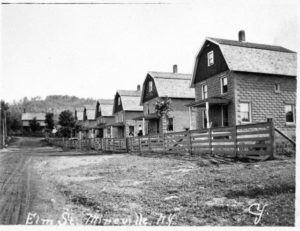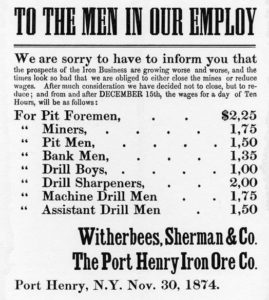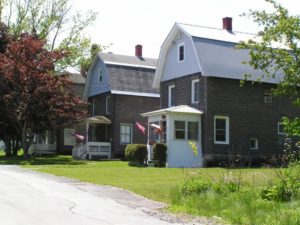Andebit et beaqui corendit, ut quostes esciendion re dit ad et prae parion es quia quas alibus sam, omnim faciden ducipidiat arum autem nobis enis es voat

17. The Concrete Homes of Bridal Row
Controlling the Labor Force
Listen to the Site 17 Iron Story Audio Narration

As the economics continued to decline after the 1900s, the Witherbee Sherman Company began to focus more and more on local control, capitalizing on perceived ethnic differences and values. “The company, in essence, built a new town structured with deliberated regard to ethnicity and class,” writes historian Valerie Rosenquist. “It consisted of three definable groups: management, old immigrants (predominantly Irish, French-Canadian, some German, and Scandinavian), and new immigrants—the Eastern and Southern Europeans, which included large numbers of people from the various political divisions of Poland, Lithuania, Italy, and Spain. The company demonstrated its new paternalism in the physical layout of the buildings and the town itself.”
“The houses were laid out in such a manner as to establish and reinforce in a physically permanent way ethnic and class identities and distinctions: the more socially worthy, the more expensive and luxurious the housing,” writes Rosenquist. She believes the actions by Witherbee, Sherman, and later other mining companies led to the dependency of many communities of laborers on one company.
 Writing about Mineville housing in 1915, chief engineer S. Lefevre described the company as “in the same position as the old woman who lived in the shoe.” Those workers with families had then over a thousand children, five hundred of school age, necessitating an additional classroom and teacher, on average, each year. In 1905, a tenement was constructed to house 60 Italian immigrants, all male employees of the mine. The company followed a practice of segregating workers by race and nationality. Lefevre describes this practice matter-of-factly in his 1915 article:
Writing about Mineville housing in 1915, chief engineer S. Lefevre described the company as “in the same position as the old woman who lived in the shoe.” Those workers with families had then over a thousand children, five hundred of school age, necessitating an additional classroom and teacher, on average, each year. In 1905, a tenement was constructed to house 60 Italian immigrants, all male employees of the mine. The company followed a practice of segregating workers by race and nationality. Lefevre describes this practice matter-of-factly in his 1915 article:
“Houses have gone up a few at a time wherever a clear space could be found and the slopes were not too steep. This has its advantages, as it separates the dwellings into various groups, which makes it possible to segregate the different nationalities; thus we have an American quarter, an Italian, and a Polish-Slavish-Hungarian district.”

The single- and double-family homes on Bridal Row include six identical single-family, concrete block homes, built by Witherbee-Sherman for newly married couples—hence the original street name Bridal Row. Like much of the other company buildings in town, they were built from concrete made with the waste mine tailings. These were the first concrete block homes built by the company, completed in 1906 at a cost of $1,350 each. Today, this group is the most intact group of identical row houses in the Mineville-Witherbee area.
Travel Tools
At the Intersection with Power House Road/ County Route 6, turn right and then immediately left onto Bridal Row. This short but sweet street provides an intact sense of what a typical mining neighborhood would have looked like. At the end of Bridal Row, turn left onto Rt. 6A. At the V, keep right onto Wasson Street.


